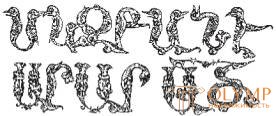
Armenian and Georgian art (see above, Vol. 2, I, 4) at the end of the XI century in many respects fell under Turkish-Arab influence; however, the main form of the temple, as evidenced by the small church of Surb Grigor in Ani, 1215, remained old. What kind of welcome was now the Arabian ornaments, can be seen from the kufic inscription (see vol. 1, fig. 646) in 1063 over the portal of one church in Gelati, in Georgia. However, Georgia at this time passed from the Armenian architectural forms to the Byzantine. In the large church of the Gelati monastery (1089–1126) we find three eastern apses, inside are semicircular, outside are many-sided, as in purely Byzantine churches; The Armenian ornamentation, which received a particularly magnificent development in Georgia, is now again being mixed, along with Turkish-Arabic motifs, by the Byzantine floral curls.

Fig. 124. The letters of the Armenian Bible composed of bird figures in 1375. According to Strigovsky
For the study of Armenian painting, illustrated manuscripts are almost the only material in which even figured images, remaining, in essence, Byzantine, increasingly take the Armenian footprint. Already in the tables of the canons of the Armenian Gospel in the library of the monastery of San Lazzaro, near Venice, manuscripts in 1193, along with the semicircular arches there are three-quarter arches, capitals and bases of the columns take the Armenian spherical shape, and the Persian influence appears in the sharp features of the colored ornament. Starting from the 13th century, true Armenian miniature painting emerged, the style of which remained almost unchanged until the 17th century. Actually biblical compositions here are copies of Byzantine originals, with insignificant additions. On the contrary, secular plots often have an Asian character. Ornamentation is consistently developing further, based on the above mentioned beginnings. “Bird” ornament, basically its ancient Christian, becomes a typical belonging of the national Armenian art. In the initials of the Bible in 1375, stored in the library of the Armenian Mkhitarian community on the island of San Lazzaro, we find the most bizarre combinations of bird and plant forms (Fig. 124).
Fields of manuscripts are ornamented with palmettes with images of sirens inserted into them. Tikkanen pointed to the Byzantine origin of such motifs in the letter E of one Armenian manuscript of the 15th century (Fig. 125). This Armenian art is obliged by its artistic and historical significance to the elements brought into it from outside; it only further developed only a little, and even less able to create something new.

Fig. 125. Initial E: a - from the Byzantine manuscripts of the Berlin Royal Library; b - the Armenian manuscript of 1469. According to Tikkanen
Что бы оставить комментарий войдите
Комментарии (0)